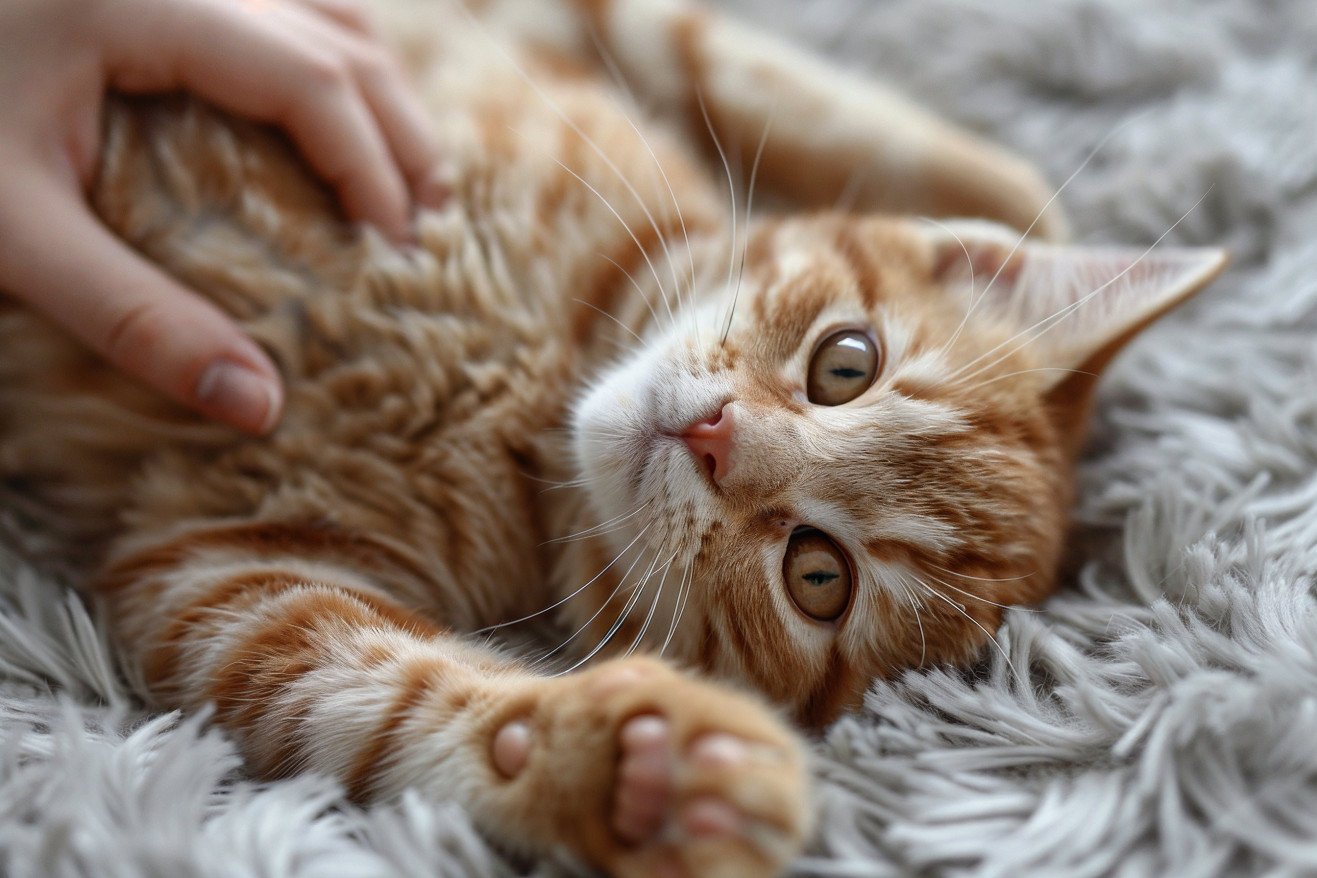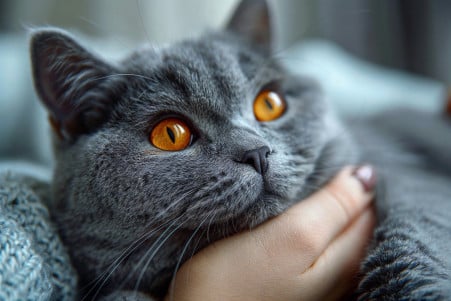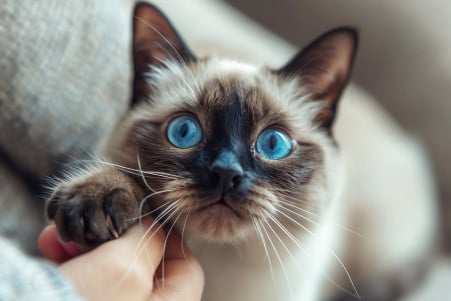Why Do Cats Hate Belly Rubs? The Psychology of Feline Tummy Time
23 April 2024 • Updated 23 April 2024

On the surface, the act of giving a cat a belly rub seems like a sweet way to show your pet some love, but the way a cat responds to a belly rub can go from pure happiness to a sudden attack – so what gives? Since exposing their belly is a sign of vulnerability for cats, they only like belly rubs when they feel safe and secure with the person who's petting them. In general, cats prefer to be pet in other areas, especially the cheeks, head, and shoulders, which is where their scent glands are located.
By looking at studies conducted by animal behaviorists, you'll learn about the psychology behind why some cats love belly rubs and others hate them. You'll also learn how to tell if your cat is in the mood for a belly rub based on their body language and natural instincts. This will help you understand how to form a more positive, trusting relationship with your cat by learning how to understand their needs.
Do cats like belly rubs?
The Evolutionary Instinct Behind Belly Exposure
Although a cat showing its belly may look like an invitation for some love, the act of exposing the belly has evolutionary roots that go back to vulnerability and self-defense. A cat's belly houses its organs and is a sensitive area that's close to the skin, so it's a place that cats instinctively want to protect. When a cat rolls onto its back, it's not a sign of submission but a way to expose the belly so the cat can use its claws and teeth to defend itself, according to the Northern Illinois Cat Clinic.
Cats may also show their bellies when they're playing or engaging in hunting behavior, practicing their moves for when they need to pounce on prey. This is a natural reaction that goes back to their wild ancestors, who had to protect themselves from other animals. As TreeHugger points out, a cat's stomach area is also sensitive because it has hair follicles that are super sensitive, which can make belly rubs feel overstimulating.
Knowing this evolutionary history and a cat's natural instinct to protect its belly helps explain why many cats don't like having their exposed bellies rubbed, even when they're showing their stomach. Instead of being an invitation for some love, the cat's behavior may be a way to protect itself or practice hunting behavior. Being aware of these natural instincts is important for respecting a cat's comfort level.
How to Tell If Your Cat Likes Belly Rubs
Cats don't use words to tell you how they feel, so their body language is the only way to know if they like belly rubs. According to Catster, signs that a cat is enjoying a belly rub include rolling over to expose their belly, gently reaching out with their paws, and purring. On the other hand, Rover.com says that signs that a cat is not enjoying a belly rub include swatting, biting, a rapidly moving tail, and hiding.
It's important to pay attention to your cat's body language and stop petting them if they seem uncomfortable or overstimulated. According to Woman's World, signs that a cat is getting annoyed with a belly rub include a flicking tail, ears that are pinned back, and staring at your hand. In general, you can tell if a cat likes belly rubs based on their overall body language and vocalizations.
The Purr-fect Technique: How to Pet a Cat's Belly
If you have a cat that likes belly rubs, there are ways to do it that are safe and comfortable for the cat. Catster explains that you should start by petting the cat's sides and seeing how the cat reacts. If the cat seems comfortable, you can slowly move to petting the belly, but be careful of overstimulating the cat.
The Vancouver Is Awesome article suggests that you should avoid making direct eye contact with the cat and making sudden movements that could scare the cat. If the cat does start to act aggressively, stay calm and slowly pull your hand away to avoid getting scratched. As the article points out, "most of the time when people get scratched, it's not the cat scratching the human, it's the human scratching themselves on the cat's claws."
By letting the cat set the pace and respecting their comfort level, you can ensure that both you and your cat have a positive and safe experience.
Trust and Positive Associations
If your cat doesn't like belly rubs, you can use patience and positive reinforcement to help them feel more comfortable and trusting. The I Can Has Cheezburger article suggests that you can slowly move closer to the belly area, rewarding the cat for not reacting negatively at each stage. The article also recommends pairing belly rubs with other positive things like treats or playtime to help your cat learn to like them.
According to Cats.com, you should never force your cat to accept belly rubs if they don't want them. Instead, you can try to work up to it by moving in slowly and starting by touching their paws. If your cat lets you do this, you can give them a treat to reinforce the behavior. The Medium article explains that the rhythmic motion of belly rubs can help cats regulate their breathing and heart rate, which can help them feel less stressed.
Clicker training can also be helpful, and the I Can Has Cheezburger article suggests that you can click and treat your cat when they let you touch their belly, gradually increasing the amount of time you touch them before clicking and treating. That said, it's important to remember that every cat is different, and some may never come to enjoy belly rubs.
Age and Life Stage
A cat's age and life stage can have a big impact on how much they like belly rubs. As National Geographic notes, kittens are more likely to be open to physical touch and social play, including belly rubs, than adult cats. This is because they are still developing their instincts and haven't yet learned to associate certain sensations with overstimulation.
As cats grow up, they may become more wary and selective about when and how they want their belly touched. The Cornell Feline Health Center points out that as cats age, they may experience a decrease in mobility and an increase in sensitivity, which means that people need to be more careful when petting senior cats. Pregnant cats may be okay with belly rubs if they have been in the past, but people should be careful to make sure that they're not causing them any discomfort.
It's important to take into account each cat's individual preferences based on their age and life stage to ensure that you're fostering a healthy and trusting relationship. By being aware of these differences, cat owners can make sure that they're finding the best ways to bond with their pets.
How to Introduce Belly Rubs to a New Cat
If you are bringing a new cat into your home, it is important to remember that trust is built over time and that you should let the cat get used to their new surroundings at their own pace. PAWS Chicago explains that cats need comfort, security, and familiarity, so letting them explore their new home on their own terms is important. This means no direct eye contact or sudden movements. Instead, use treats and praise to reward good behavior, but don't force physical contact until the cat is ready.
If the cat is open to it, you can start to introduce petting, but pay attention to their body language to see if they are ready for belly rubs. The International Cat Care article suggests that you introduce the other cat's scent before you introduce the cats in person so that they can get used to each other's presence. Remember to be patient and let the cat set the pace, as the Medium article explains that it can take weeks or even months to build the trust and comfort needed for belly rubs.
Conclusion: Understanding Feline Preferences for a Better Relationship
A cat's preference for belly rubs is likely a combination of their individual personality, socialization history, and the physical experience of being petted on the belly. PuaInta notes that cats who have had positive experiences with belly rubs in the past are more likely to enjoy them. If a cat has been petted gently and lovingly on their belly from a young age, they may associate belly rubs with positive feelings of comfort and security.
Many cats don't like belly rubs, and there are a number of reasons that cats may react negatively or feel uncomfortable when they're petted on the belly. As PuaInta points out, cats have different thresholds for touch, and while they may enjoy being petted and receiving attention, certain types of touch can be overstimulating. If a cat's threshold for touch is exceeded, it can lead to discomfort and even irritability, and belly rubs, especially if they're too rough or last too long, can easily exceed this threshold.
It's important to remember that each cat is an individual. As PuaInta observes, if a cat doesn't like belly rubs, it's not a reflection of your bond with the cat or how much they care about you. Instead, it's a reflection of their individual preferences and comfort levels.
In the end, the most important thing is to have a positive and mutually satisfying relationship with your cat. If your cat doesn't like belly rubs, respect their boundaries and look for other ways to connect and interact with them.


